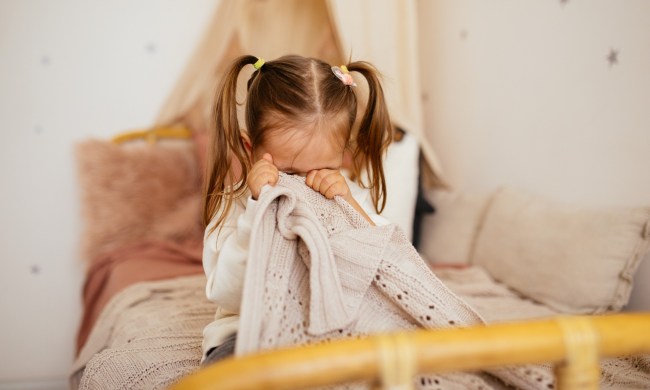If you’re a parent struggling to train your toddler to sleep through the night, rest assured you’re not alone. Lots of parents have trouble getting their children to sleep through the night. Luckily, there are plenty of things you can do to help — like making a toddler-friendly bedtime routine or experimenting with sleeping methods — so don’t give up just yet.
Here are some techniques you can employ to help your little one get a good night’s sleep.

How to create a toddler-friendly bedtime routine
Children thrive on consistency and routines. That’s why making a bedtime routine about 30-60 minutes before their bedtime is often a crucial part of getting toddlers to sleep through the night. Here are a few quick tips you can try for their nightly routine.
Start with a warm bath
Warm water can relax your little one, especially if they’re still excited and energized from the day’s activities. Make sure you’re speaking softly and calmly during their bedtime routine so they can see your relaxed behavior and emulate it.
Get them dressed and brush their teeth
Once your toddler is dried off, dress them in cozy pajamas. You’ll also want to brush their teeth, gums, and tongue, too, during this part of the routine.
Make sure they go to the bathroom
It’s very important to make sure your toddler uses the bathroom before bed, especially if they’re out of diapers or you’re in the process of potty training them. Slowly but surely, they’ll get used to going to the bathroom before bed every night.
Try some quiet time
Some toddlers still want to continue playing or running around, even after the first three steps. If that’s the case, it’s time for some quiet time. Playing right before bed makes it much harder for your little one to get shut eye. Instead of grabbing a device like an iPad or turning on the TV, do a quiet activity like:
- Reading a book together
- Tucking in your toddler’s stuffed animals or getting them ready for bed
- Doing a quick puzzle
- Singing a lullaby
- Check out their bedroom environment
If your toddler’s room is too hot or if the curtains are open and letting in a lot of light, you’ll want to fix these things. You want their bedroom environment to be as cool, calming, and comfortable as possible.
You can also try using white noise to help them go to sleep, like the sound of rain, waves crashing on a beach, or crickets.

Sleep training methods you can try
In addition to implementing a toddler-friendly bedtime routine, there are also several sleep training methods you can experiment with to help your little one sleep.
Camping it out
If your toddler is used to sleeping in your bed, but it’s time for them to transition to their own bed, you can try the “camp it out” method. After their bedtime routine, tuck them into their own bed and consider sleeping in the room with them, on an air mattress, for a few nights.
Once your toddler begins to get more comfortable, you might stay in the room until they fall asleep and then leave to sleep in your own bedroom. Eventually, you’ll be able to tuck them in and head back to your own bedroom with no problem at all.
Crying it out
Another option is to let them “cry it out.” Although it’s tough, with this technique you won’t smother them with hugs and kisses. Instead, you don’t come back into their bedroom even if they start to cry or scream. It’s OK to poke your head in and reassure them by telling them they’re all right and that you love them.
This technique isn’t easy, but it’s often worth it for some parents who are at their wit’s end trying to get their toddler to sleep through the night.
Fading
The fading method might be a bit easier for parents, but it’s similar to the “crying it out” technique. You can calm them down, but you’ll leave afterward. If they cry again, you can come back in again, reassure them, and go once more. You’ll repeat this until they fall asleep for good. Eventually, they’ll become accustomed to sleeping in their own room.
Essentially, you’ll tuck your toddler in like normal after their bedtime routine. If they start crying, wait at least five minutes before going back into their room.
Getting your toddler to sleep through the night might be a challenge at first, but it’s not impossible. Even if the routine doesn’t seem to be sticking, keep trying. Eventually, their bedtime routine will click, and they’ll be able to sleep through the night.


